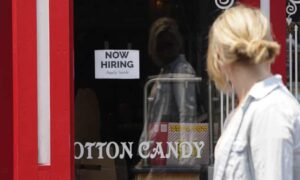
Employers added 275,000 jobs across the US last month, as the labor market continues to grow at a clip in the face of the high interest rates.
Job growth exceeded expectations of 200,000 on Wall Street in February and rose from the previous month’s revised rate of 229,000.
Unemployment stood at 3.9%, according to data released on Friday morning by the Bureau of Labor Statistics (BLS), a 0.2% increase compared to January. The unemployment rate has now been under 4% for 25 consecutive months, the longest such streak since the 1960s.
Industries that saw an increase in jobs include healthcare, government employment and food services and drinking places.
While jobs continue to be added each month, activity in the labor market has cooled. The change in employment for December was revised down by 43,000, from 333,000 to 290,000, and January was revised down by 124,000, from 353,000 to 229,000.
Job openings and the number of workers quitting their jobs fell slightly in January, according to official data released earlier this week. The number of workers who resigned from their jobs in January, at 3.385 million, was the lowest since January 2021.
Layoffs have, meanwhile, climbed sharply. Outplacement firm Challenger, Gray & Christmas reported yesterday that layoffs last month were the highest of any February since 2009, at 84,658: up 3% on the month and 9% on the year.
But jobs growth has remained robust. Private sector payrolls increased by 140,000 last month, according to report from payrolls firm ADP, an increase on January.
“Job gains remain solid. Pay gains are trending lower but are still above inflation,” said Nela Richardson, chief economist at ADP. “The labor market is dynamic, but doesn’t tip the scales in terms of a Fed rate decision this year.”
Economists have been closely watching jobs and inflation figures as the Federal Reserve tries to guide the economy towards a so-called “soft landing”, where price growth is normalized and a recession is avoided.
Two years ago the Fed embarked upon an aggressive campaign to bring down inflation. It peaked at 9% in June 2022, and has since retreated to 3.1% in January.
The Fed, which wants inflation to fall to 2%, increased interest rates 11 times to between 5.25 and 5.5% – the highest in over 20 years – as it battled to bring it down.
